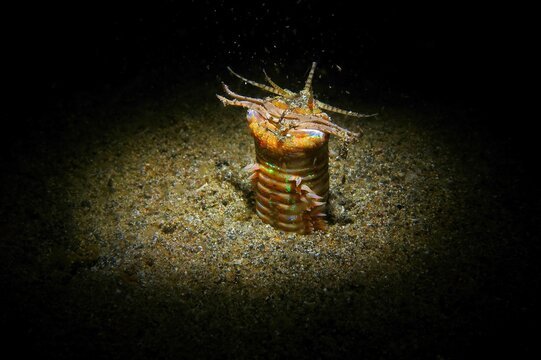
Understanding Bobbit Worms
Bobbit worms, scientifically known as *Eunice aphroditois*, are a type of polychaete worm found in tropical and subtropical waters around the globe. These creatures can grow up to ten feet long, although most are typically around three feet. With their bright colors and segmented bodies, they might look harmless, but don’t let their appearance fool you.
They thrive in environments like coral reefs and sandy bottoms, where they can easily camouflage. Think of them as the ninjas of the ocean floor—stealthy and prepared to strike at any moment. Typically, you won’t even notice them until it’s too late for their prey.
The Mechanics of the Strike
Now, you might be wondering, what makes a Bobbit worm’s strike so remarkable? The secret lies in its specialized mouthparts, which can open wide to capture prey. When a meal approaches, these worms utilize powerful muscles to extend their jaws and grab their victim—usually a fish or other small animal.
When they strike, they rely on quick reflexes. Their jaws can snap shut in a mere fraction of a second. To put that into perspective, it’s like a camera shutter closing in the blink of an eye. This speed not only allows them to catch prey but also helps them avoid detection.
How Fast Are Bobbit Worm Strikes?
Research shows that Bobbit worms can strike at speeds of up to **1 meter per second** (about 3.3 feet per second). This might not sound overly fast compared to other ocean predators, but when you’re a worm that lives hidden under the sand, it’s incredibly efficient.
Their speed is necessary for survival. If they didn’t strike quickly, prey could escape, leaving the Bobbit worm hungry. This adaptability shows how evolution fine-tunes species to thrive in their environments, ensuring they get the nourishment they need.
A Unique Hunting Strategy
Bobbit worms are ambush predators. They bury themselves in the substrate, exposing only their heads. This allows them to blend into their surroundings, making it hard for potential meals to spot them. They wait there, sometimes for hours, until they sense movement nearby.
When prey comes within striking distance, they spring into action. Their lightning-fast strike doesn’t just capture the prey; it also allows them to pull it back into their burrow to consume it safely. It’s like fishing with a rod, only the worm is the hook, line, and sinker all in one!
Bobbit Worms in Their Ecosystem
You might be curious about what role Bobbit worms play in the marine ecosystem. These worms are important as both predator and prey. While they hunt smaller fish and crustaceans, they can also fall victim to larger fish and sea creatures. This delicate balance helps maintain the health of their underwater habitats.
Additionally, Bobbit worms contribute to the diversity of the ocean floor. They aerate the substrate while burrowing, which helps circulate nutrients in the sand and supports other marine life. So, while they might seem like solitary hunters, their impact is felt throughout their ecosystem.
Final Thoughts on Bobbit Worms
In summary, Bobbit worms might not be the most glamorous ocean inhabitants, but their speed and hunting technique are nothing short of fascinating. They strike with the quickness of a lightning bolt, capturing prey in the blink of an eye.
Understanding the Bobbit worm and its remarkable adaptations gives us a glimpse into the wonders of marine life. The ocean is full of surprises, and these creatures are a perfect example of how unique and intricate life can be beneath the waves. So, next time you’re reminiscing about the ocean, remember the stealthy, speedy Bobbit worm—it truly embodies the thrill of underwater life.
